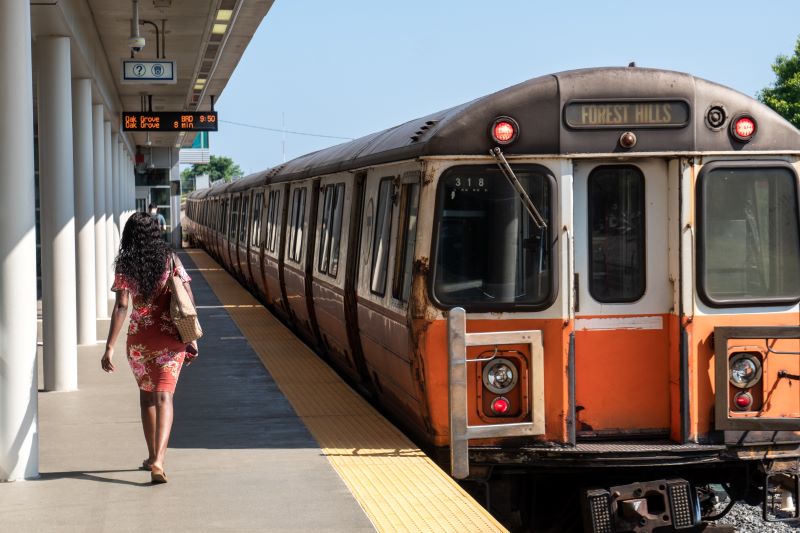Buses, Barriers and Bias: Social Justice and the MBTA

If you’ve ever explored the Greater Boston area, chances are you’ve done so with the MBTA, or Massachusetts Bay Transportation Authority, New England’s largest public transportation provider. According to Avery Heinz ’23, whether you traveled via subway, bus, commuter rail or ferry, your experience was likely influenced by your economic status and the color of your skin — a direct result of the structural racism embedded in America’s public transit policies.
Heinz, an Accounting major who grew up 40 miles northwest of Boston in Leominster, Massachusetts, says he’d never really thought about public transportation until last summer, when he began commuting to downtown Boston for an internship with technical accounting advisory firm RSM. (The experience, facilitated by Bentley’s Pulsifer Career Development Center, led to a full-time job offer, which Heinz accepted prior to graduating magna cum laude in May.) He says his twice-weekly journeys aboard the MBTA’s commuter rail — which involved an hour-plus commute each way and cost more than $200 per month — encouraged him to think more critically about the advantages and limitations of the MBTA and how they impact the lives and livelihoods of its users.
He decided to explore the subject further by making it the focus of the independent research project required of his second major, Liberal Studies: Political Economy and Development. Under the direction of Bentley’s Juliet Gainsborough, a professor of political science, Heinz began investigating the equity implications of public transportation in Massachusetts; what he discovered made him realize that the MBTA is “ignoring the needs of the very people the transit system is designed to serve.” As he says today, “Public transportation has greater significance than simply traveling from one point to another. Access to affordable and reliable transportation can have a cascading effect on all aspects of an individual’s civic life.”

Through his research, Heinz identified both national and local factors affecting the MBTA’s effectiveness. Among the biggest issues, he says, is the fact that infrastructure investments have historically prioritized highways. Since the 1980s, roughly four times as much federal funding has been allocated to roadways as public transit, primarily due to lobbying from the gas and oil industry. As a result, “transportation expenditure has disproportionately served white and wealthier households,” Heinz says, which are more likely to own personal vehicles. Metropolitan areas across the country are now grappling with congested roadways: A recent study found that Boston drivers spend 134 hours sitting in traffic each year, at a personal cost of roughly $2,270 in gas and wasted time.
Channeling investment into roadways has also left public transit systems — which can include buses, subways, commuter trains, trollies and ferries — chronically and critically underfunded, he adds. According to the U.S. Department of Transportation, the nation’s systems are collectively suffering from a $90 billion maintenance backlog that has affected the accessibility, reliability and safety of their services. This is nowhere more evident than at the MBTA, Heinz notes, which took the unprecedented step of shutting down one of its busiest subway lines for 30 days last fall to implement long-deferred construction and safety upgrades.

It’s no coincidence that the subway line in question — the MBTA’s Orange Line, which serves 100,000 riders daily — is primarily used by people of color, Heinz says, given that transportation policies and priorities reflect the systemic racism that underlies urban development. From discriminatory practices like redlining, which intentionally excluded Black Americans from buying suburban homes, to the Federal-Aid Highway Act of 1956, which enabled city planners to purposefully segregate and impoverish communities of color through the construction of urban roadways, America’s public transit systems have focused almost exclusively on the needs of white, wealthy and suburban households.
The ripple effects of these policies are evident today: A 2022 MBTA passenger survey found that 58% of all transit customers self-identified as people of color, a number disproportionate to the actual percentage (30.4%) of Massachusetts’ Black, Asian, Latino and multiracial residents. The same survey also found that commuters of color are overrepresented on the Orange Line subway (59%) and buses (68%), which Heinz notes are among the MBTA’s worst-performing services. “One study found that Black passengers spend, on average, 64 more hours on the bus than white riders because the routes serving their neighborhoods are less frequent and more unreliable,” he explains, adding that travel time disparities “create significant barriers to educational, employment and other economic opportunities.”
RELATED: Do U.S. cities discriminate against runners of color?
Yet, while Heinz acknowledges the “glaring deficiencies” of MBTA services, he also believes inequities can be addressed through collaborative efforts that incentivize public transit use. He believes Massachusetts should implement congestion pricing, also known as variable tolling, which charges single-occupancy vehicles increased fees during peak travel hours. “Major cities like London and Stockholm have had great success with these programs,” he says, “which have led to reduced traffic, lower carbon emissions and sizeable new revenue streams, which they’ve subsequently reinvested in their public transit systems.”
Heinz also recommends expanding reduced fare options for low-income customers. The MBTA currently offers discounts to middle and high school students, seniors aged 65 and older, and disabled passengers, he notes, but low-income options are available only for young adults ages 18 to 25. Proportionally, America’s lowest earners spend more on transportation costs than the nation’s highest earners; offering reduced MBTA fares to older adults from households at or below 200% of the federal poverty level (currently defined as $27,750 for a family of four) would help alleviate this burden, saving each rider about $500 annually. Discounting fares, Heinz says, is therefore an “ideal mechanism for demonstrating the MBTA’s commitment to social equity.”
He also believes the MBTA could partner with members of Boston’s business community to integrate public infrastructure and private development, as they did with New Balance in 2015, when the athletic company paid $20 million to build a commuter rail station at its headquarters in Brighton. “Affordable, reliable public transportation is essential for a thriving economy,” Heinz says, citing a report from nonprofit A Better City indicating that areas served by the MBTA house 74% of all jobs in the state and generate 84% of Massachusetts’ gross domestic product. “By providing capital investments for public transportation, companies can boost productivity among their own workers while simultaneously strengthening the local economy.”
Heinz admits that, prior to embarking on his research project, he — like many Americans — wasn’t particularly concerned about issues he felt didn’t affect him personally. Now, he says, he appreciates the importance of civic engagement, and understands that all members of a community benefit when social inequities are acknowledged and addressed. “The treatment of a nation’s most vulnerable citizens is one of the greatest indicators of its strength,” Heinz says. He’s inspired to use the knowledge he’s gained at Bentley to advocate for change: “Lower-income communities in Massachusetts will continue to have limited opportunities for as long as public transportation remains a peripheral issue.”

